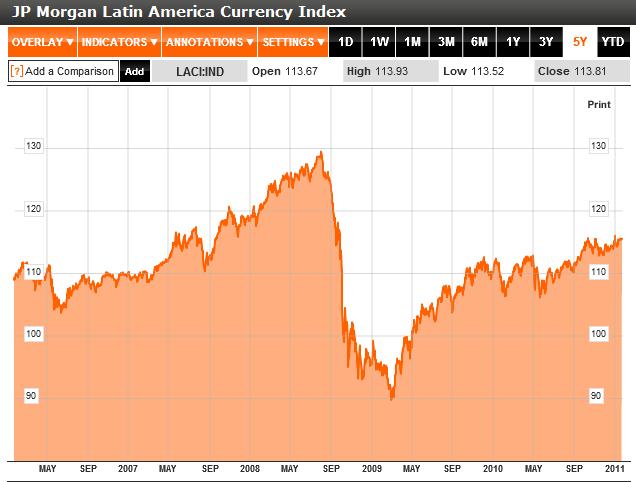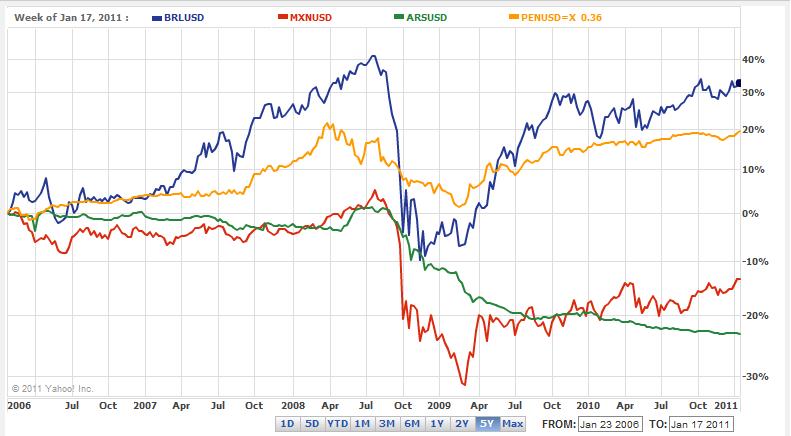A few years ago, I wouldn’t deign to discuss such obscure currencies as the Chilean Peso and the Peru New Sol. But this is a new era! These currencies â€" and their Central Banks â€" are being thrust into the spotlight as they join more established Latin American countries in the fight to contain currency appreciation.

Major Latin American currencies have collectively appreciated more than 29% since March 2009. (When researching this post, I discovered the fantastically apropos JP Morgan Latin American Currency Index, which is based on the currencies of Mexico, Columbia, Brazil, Argentina, Peru, and Chile, and is displayed in the chart above). That includes a nearly 45% gain in the Brazilian Real and a 30% rise in the Mexican Peso, with more modest gains by the Peru New Sol, Chilean Peso, and Colombian Peso. The Argentinean Peso seems to be dragging the entire index down, having never recovered from the sovereign debt default in 2008.
Over this period, capital has poured into Latin America: “Net private inflows surged to $203.4 billion last year from $57.5 billion in 2003, according to the World Bank. Stock market indices in the region are closing in on all-time highs, and bond prices have risen (i.e. 32% gain in Colombian bonds in 2010) to such an extent that spreads to Treasury Securities â€" the most common comparison â€" have narrowed to record lows. Perhaps this not for naught, as the region recorded economic growth of 5.7% in 2010 on the basis of rising commodities prices, aggressive/fiscal policies, and an overall global economic recovery.
Faced now with rising inflation (6% in Brazil, 4.5% in Chile, 11%+ in Argentina, etc.) and declining export competitiveness, Latin American countries have moved to stem the appreciation of their respective currencies. Brazil, whose finance minister coined the term ‘currency war’ and has been one of the most aggressive interveners in the forex markets, has been the most active. Its Central Bank continues to buy massive quantities of Dollars, it has raised taxes on capital controls, and most recently it moved to limit the ability of banks to short Dollars as a means of betting on the Real’s appreciation.
Meanwhile, “Chile, which hadn’t bought dollars in the foreign-exchange market since 2008, announced Jan. 3 it would purchase a record $12 billion, equal to 43 percent of the country’s currency reserves. In Colombia…the central bank is buying at least $20 million a day in the spot market. Peru purchased $9 billion last year, the second-biggest amount ever. While Mexico has so far refrained from intervention, it recently negotiated an IMF credit line which it could potentially tap for the purpose of holding down the Peso. All together, the Central Bank reserves of the six currencies mentioned above rose 16.5% in 2010 and now exceed $500 Billion.
It’s difficult to discern whether this intervention is having any impact. On the one hand, the raising of reserve requirements will certainly make it difficult for domestic banks to short their own currencies. In addition, some foreign speculators are getting spooked about all of the uncertainty and have moved to limit their exposure to Latin America. “There might be every macro reason in the world to love the Brazilian currency, but the randomness of policy to try and stop appreciation makes us want to have a smaller position,†explained one fund manager.
On the other hand, there is the possibility that legitimate institutional investors will also be scared away, which is problematic because Latin America remains reliant on foreign capital to fund its lavish fiscal spending and growing trade deficits. “There’s always a danger that by having capital controls, you can force some good capital to stay out of the country,†summarized one analyst. There are also concerns that Central Banks are losing sight of the bigger picture: “Central banks view the level of exchange rates as the priority rather than using them to help slow inflation.â€
The problem, ultimately, is that Latin American countries want to have their cake and eat it too. The President of Colombia spoke recently of 5% GDP growth and the country’s desire to “put itself in the coming years among the most dynamic economies in the world,†but has whined about the upward pressure on the Peso. Brazil’s newly elected president has also spoken of becoming a global economic leader while its Finance Minister continues to sound off on the currency war. Meanwhile, Chile’s economy remains heavily tilted towards copper exports (it is apparently the world’s largest producer), and then wonders why rising prices have lifted the Chilean Peso. All blame the Fed’s Quantitative Easing Program for their currency woes and use China’s currency peg as basis for intervention.

In short, the appreciation of Latin American currencies has largely mirrored fundamentals. Individually and as a group, their exchange rates are still well below the bubble levels of 2008. Most of the rise over the last two years has merely offset the precipitous declines that took place during the height of the credit crisis. In addition, given the divergence in performance between individual currencies, it’s clear that investors (whether speculative or passive) are discerning. They have flooded the commodities producers with cash, while continuing to punish Mexico and Argentina over fiscal issues.
For that reason, there is reason to believe that most of the region’s currencies will continue to appreciate. Central Banks might manage to stall that appreciation in the short-term, but once they accept the inevitability of interest rate hikes (as Brazil already has) as the cure for inflation, the long-term upward path will be restored. Summarized one economist, “In these games of cat and mouse, I think policy makers will probably lose. There is too much unregulated capital in the world, particularly in developed countries. These guys will find ways around various restrictions.â€

Business | Christians | Coupons | Discussions | Gamers
Legal | Politics | Sports | Teens | Webmasters


No comments:
Post a Comment